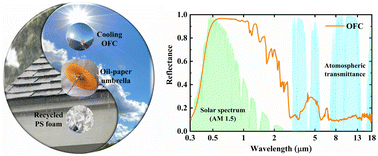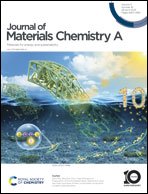Oil-paper-umbrella-inspired passive radiative cooling using recycled packaging foam†
Abstract
Passive daytime radiative cooling (PDRC) is a promising energy-saving cooling method to cool objects without energy consumption. Although numerous PDRC materials and structures have been proposed to achieve sub-ambient temperatures, the technique faces unprecedented challenges brought on by complicated and expensive fabrication. Herein, inspired by traditional Chinese oil-paper umbrellas, we develop a self-cleaning and self-cooling oil-foam composite (OFC) made of recycled polystyrene foam and tung oil to simultaneously achieve efficient passive radiative cooling and enhanced thermal dissipation of objects. The OFCs show high solar reflectance (0.90) and high mid-infrared thermal emittance (0.89) during the atmospheric transparent window, contributing to a sub-ambient temperature drop of ∼5.4 °C and cooling power of 86 W m−2 under direct solar irradiance. Additionally, the worldwide market of recycled packaging plastics can provide low-cost raw materials, further eliminating the release of plastics into the environment. The OFC offers an energy-efficient, cost-effective and environmentally friendly candidate for building cooling applications and provides a value-added path for plastic recycling.



 Please wait while we load your content...
Please wait while we load your content...